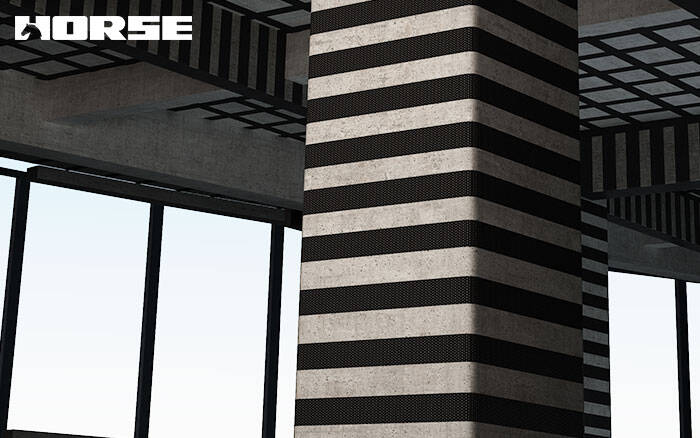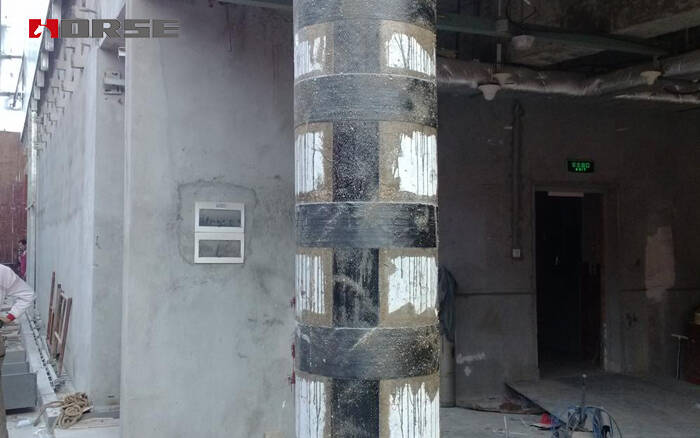Solutions
Horse Construction offers full range of structural strengthening materials with technical supports, documentation supports, products supports, project supports.
strengthening column with carbon fiber reinforced polymer(CFRP) wrap

The characteristics of traditional strengthening reinforcement methods, fiber reinforced polymer(FRP) reinforcement methods are introduced respectively. In addition, the application characteristics and development of carbon fiber wrap and carbon fiber strips are elaborated to provide reference basis for future engineering practice.
Research background of strengthening reinforced concrete structures
The mechanical properties of concrete materials are relatively stable, and the material properties can be brought into full play after being effectively bonded with steel bars. Reinforced concrete has better fire resistance, durability, integrity, etc., and the required materials are more convenient to obtain and transport. All of these have made reinforced concrete widely used in the field of construction. So up to now, reinforced concrete is still the most widely used building material in the field of civil engineering.
Significance to the reinforcement and strengthening of concrete structures
Since the rapid development of my country's economy and the construction of civil engineering, people have become more concerned about the safety of buildings in addition to the higher and higher requirements for the living environment. Under the influence of factors such as nature and use environment, the residential or office buildings in our country increase with the life of the buildings. Many structural facilities will have the problem that the overall or partial bearing capacity cannot meet the specification requirements or even if the bearing capacity meets the specification requirements, the comfort level cannot meet the living requirements. In response to these two issues, considering the current quality, safety, and economic benefits of our country, in many cases there is no condition for complete reconstruction of buildings. Therefore, the most appropriate way to improve the bearing capacity and comfort of the structure is to adopt a reliable reinforcement method to strengthen the structure.
Practice has proved that the use of appropriate reinforcement technology to reinforce and reinforce concrete structures can effectively increase the bearing capacity of the structure and prolong the service life of the structure, thereby meeting the requirements of the structural use function. At present, the demand for reinforcement technology in my country is getting higher and higher. Building reinforcement can not only save resources, but also has good social benefits.

Characteristics of traditional reinforcement methods
The following are several commonly used reinforcement methods, their advantages, disadvantages and scope of application
① Enlarged section method
The method of increasing the cross-section increases the bearing capacity and rigidity of the component by increasing the cross-sectional area of the structural component. This method usually has obvious effects on improving the bending, compression, shear, and tensile bearing capacity of components, and is widely used in the field of engineering reinforcement. But because it will increase the cross-sectional size of the component and reduce its use space, it is not applicable in some specific projects.
②Outsourcing steel reinforcement method
The outer steel reinforcement method in which the reinforced component is wrapped with section steel or steel plate can effectively improve the bearing capacity and rigidity of the component. This method can increase the compressive and flexural properties of the component almost without increasing the cross-sectional size of the component. However, the disadvantage is that it consumes more resources and requires a large investment.
③Change the reinforcement method of the force system
Changing the force system reinforcement method is to change the structural force system through a series of means such as adding pivots. It can effectively reduce the calculation span of structural members, increase the bearing capacity of structural members, and reduce the deflection and crack width. However, this method will affect the normal production and living and building layout around the structure, and will also reduce the space used.
④Reinforcement method of fiber reinforced polymer(FRP)
In recent years, with the decrease of fiber prices, the reinforcement method of fiber composite material (FRP) attached to the outside of the component has gradually emerged. Due to the good tensile strength of fiber materials, it can effectively improve the load-bearing capacity and rigidity of the concrete components after being bonded. It has good effects in the bending, shear, torsion, seismic and corrosion resistance of concrete structures.
FRP mposite reinforcement method
After years of engineering practice and scientific research, fiber reinforced composite materials have proven their own advantages: light weight, high strength, and corrosion resistance, and they have been widely recognized and used. FRP includes: CFRP (carbon fiber), GFRP (glass fiber), AFRP (aramid fiber), BFRP (basalt fiber). After the concrete column is reinforced by FRP, the lateral deformation of the concrete is obviously reduced, and the ultimate compressive strength and ductility of the concrete column are greatly improved.
① The physical properties of FRP:
The density of FRP ranges from 1.25 to 2Bg/cm3, which is 1/6 to 1/4 of steel. Low density can reduce weight and facilitate transportation and installation. FRP should not be used in high temperature structures. The softening temperature of FRP is called "Grass Transition Temperature Tg", which mainly depends on the type of resin, usually 65~122°C. When the temperature exceeds Tg, the elastic modulus of FRP will be greatly reduced.
② Mechanical properties
As we all know, the main force direction of FRP is the direction mainly parallel to the fiber, that is, the axial direction. Tensile strength, compressive strength and bonding properties are the main mechanical properties of FRP.

tensile strength
Fiber is the basis of FRP tensile strength, and resin mainly plays a certain auxiliary role. The stress-strain curve of fiber, resin and FRP is shown in the figure above. The stress-strain relationship of FRP is linear elastic relationship. The ultimate strength of fiber is higher than that of FRP. The ultimate tensile strain of the resin is higher than the ultimate tensile strain of FRP and fiber, which indicates that the resin breaks after the fiber breaks.
compressive strength
The compressive strength of FRP is lower than the tensile strength. The compressive strengths of GFRP, CFRP, and AFRP are 55%, 78%, and 22% of the tensile strength, respectively. In most cases, the compressive strength of FRP is directly proportional to the tensile strength of FRP.
bonding performance
The service performance and bearing capacity of the structure are affected by the bonding performance, and the FRP form, material properties, geometric dimensions and FRP surface shape can all affect the bonding performance.
③ Long-term performance
creep fracture
The creep fracture of FRP is the sudden fracture of FRP under long-term constant load. And the endurance time of FRP gradually decreases as the load duration increases.
fatigue performance
FRP has good fatigue resistance when the fiber and resin are well bonded, and it is less affected by external influences.
durability
The test results show that: CFRP exhibits good durability; GFRP has good acid resistance and freeze-thaw cycle performance: AFRP also has good durability.
The significance of CFRP cloth and CFRP strips in strengthening concrete columns
Whether it is a building or a structure, the most important load-bearing component of a building structure is the column structure, and the reliability and comfort of the building are closely related to it. Reinforced concrete columns are currently the most used column structure in the main structure of buildings and structures in my country. The development of the engineering field in my country is gradually transitioning from the first stage dominated by a large number of new projects to the second stage where new projects and maintenance and renovation projects coexist. Therefore, how to reliably strengthen buildings while occupying less resources is the current scientific research. Important research topics in the field.
CFRP cloth wrapping and wrapping confined concrete columns can effectively improve the axial compression bearing capacity of the columns. The use of CFRP confined concrete can significantly increase the compressive strength of concrete and improve the ductility of concrete. At the same time, CFRP reinforced concrete column technology has many advantages (high strength and light weight, durability, ease of construction, etc.) for concrete structure reinforcement and reconstruction projects. The reinforcement method of CFRP reinforced concrete columns has been applied in more and more practical projects.
In projects that use carbon fiber cloth for reinforcement and reconstruction, due to cost and construction considerations, many structures are currently reinforced with carbon fiber cloth strips. In many actual projects, carbon fiber cloth strips are also used for reconstruction and reinforcement. The bearing capacity and ductility of structural members have also been proved. The use of carbon fiber cloth strips for reinforcement can effectively increase the utilization rate of carbon fiber and has good economic benefits. Especially in terms of construction, the use of carbon fiber cloth strips for reinforcement requires little construction site and construction space, and can effectively and flexibly organize construction
Conclusion
As far as my country's current civil engineering development prospects are concerned, maintenance and renovation projects must be an important subject in the field of construction in my country. The choice of reasonable reinforcement methods is particularly important, and FRP reinforcement methods have obvious advantages. Among them, carbon fiber cloth reinforced concrete structures are widely used in actual projects. The use of carbon fiber cloth or carbon fiber strips can effectively and conveniently reinforce buildings. For practical engineering, carbon fiber cloth strip reinforcement methods are widely used. In-depth research on this issue in the field of scientific research can provide a relatively sufficient theoretical basis for actual engineering.
You can find anything here you are in need of, have a trust trying on these products, you will find the big difference after that.

High strength, unidirectional carbon fiber wrap pre-saturated to form a carbon fiber reinforced polymer (CFRP) wrap used to strengthen structural concrete elements.

High strength, unidirectional carbon fiber fabric pre-saturated to form a carbon fiber reinforced polymer (CFRP) fabric used to strengthen structural concrete elements.

High strength, unidirectional carbon fiber sheet pre-saturated to form a carbon fiber reinforced polymer (CFRP) sheet used to strengthen structural concrete elements.